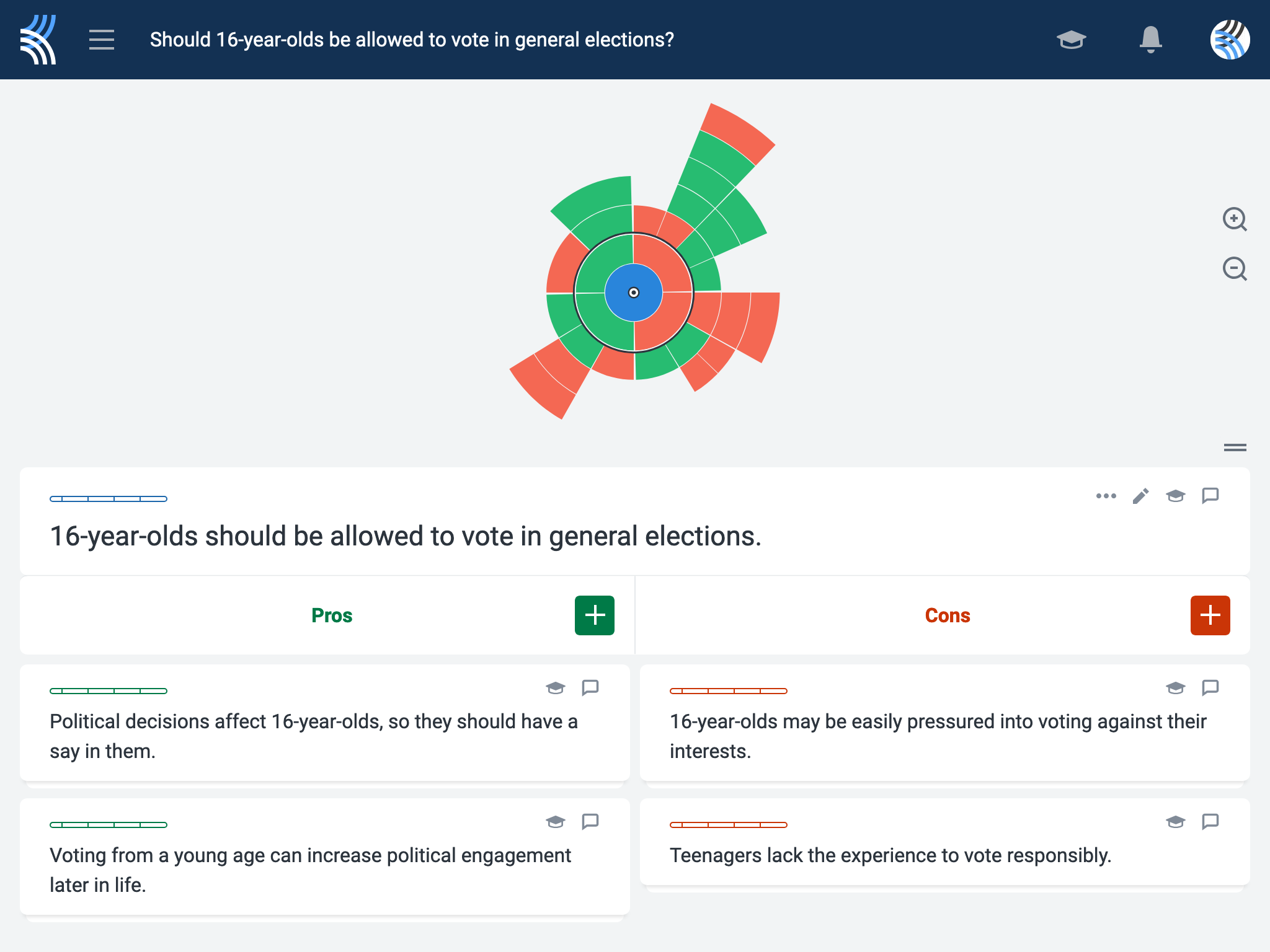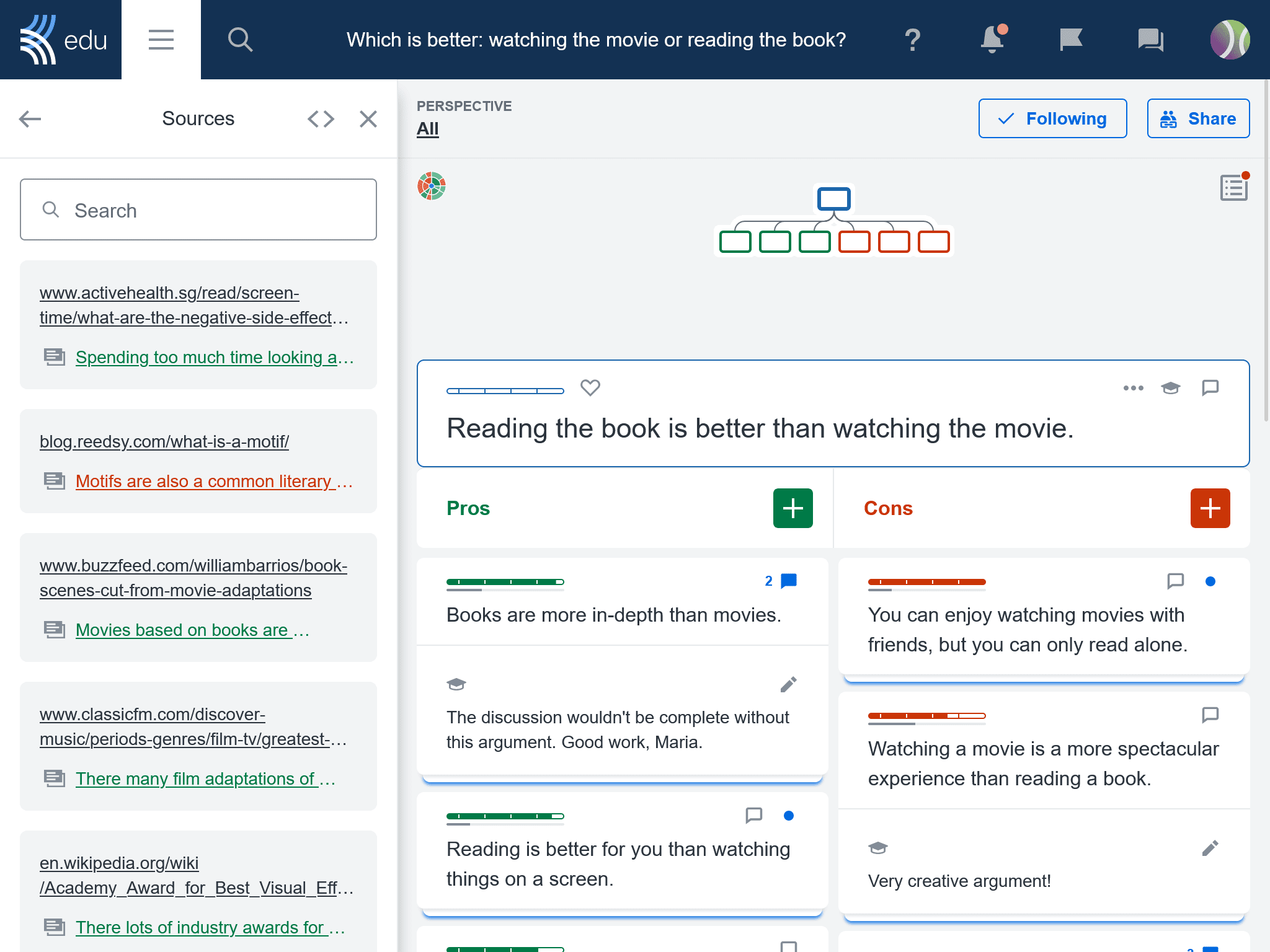Your students may be adept at both argument and persuasion in real life, but do they know the difference between argument and persuasion in writing?
In this article, we’ll examine how students can adjust elements to argue or persuade effectively, and how you can use Kialo Edu (a completely free tool for engaging classroom discussions) can support argumentative writing in your classroom!
What’s the difference between arguing to convince and persuade?
Arguing to convince centers on presenting clear, logical evidence and rational reasoning that lead the reader to accept a particular claim. It relies heavily on facts, structured analysis, and balanced consideration of opposing viewpoints.
Persuasion, by contrast, goes beyond pure logic by integrating emotional appeal and rhetorical techniques to resonate with the reader’s values and experiences.
Argument vs. persuasion: how to use them effectively
1. Consider purpose and audience
Whether arguing or persuading, focusing on purpose and audience throughout the task helps to keep writing on track.
How does this differ in argumentative writing?
In argumentative writing, the author aims to convince the reader to accept the validity of an idea, rather than a personal perspective. Thus, the author will present an objective viewpoint to a general audience, using third-person pronouns to emphasize impartiality.
How is this used in persuasive writing?
The purpose of persuasive writing is to convince the reader to agree with the author’s personal perspective. Thus, the author requires a comprehensive knowledge of the target audience to tailor content to them. Moreover, the author will often address the reader personally in the first or second person.
2. Choose a perspective

A set of balance scales is the perfect representation of perspective in persuasive and argumentative writing. The scales allow students to visualize whether they have chosen a perspective that favors one side or is equally balanced.
How does this differ in argumentative writing?
In argumentative writing, although the author may favor one side, the scales are more balanced. The author introduces the issue and debates related pros and cons, acknowledging multiple perspectives.
How is this used in persuasive writing?
In persuasive writing, imagine the scales weighted to one side. In practice, this means the writing focuses heavily on the writer’s viewpoint. The author may present some limited opposing views but will quickly discredit them.
3. Select the correct tone
Selecting the correct tone is key to achieving the purpose of the writing, as it supports the writer in conveying their attitude. Using the correct tone can enhance the writer’s message.
How does this differ in argumentative writing?
In argumentative writing, emotion is put aside as the author employs a neutral, reasonable tone to present multiple viewpoints. Combining this with an expert voice and formal style means the writer can build credibility, increasing their chances of achieving their purpose.
How is this used in persuasive writing?
In persuasive writing, authors consider ethos, or how they present themselves. They often use a conversational tone to build a relationship with the audience. Within this, authors may also employ pathos, aiming to evoke emotion through manipulating, motivating, or inspiring the reader.
4. Use evidence

Authors of both persuasive and argumentative writing employ logos, or the appeal to logic, through the use of well-structured reasoning and supporting evidence. This helps authors build solid arguments and avoid logical fallacies.
How does this differ in argumentative writing?
In argumentative writing, authors support all reasoning with robust evidence, often referencing multiple sources for one claim. To create stronger arguments, they explain, analyze, or interpret evidence. And to avoid accusations of bias, authors actively address conflicting evidence, demonstrating that it does not detract from the original argument.
How is this used in persuasive writing?
In persuasive writing, writers recognizes the power of logos in making clear, logical connections between ideas. They are often selective in their choice of supporting evidence, referring only to facts, statistics, and expert views that match their viewpoint and could evoke emotion in the reader.
Using Kialo Edu to support argumentative writing
Now that the difference between argument and persuasion is clear, let us persuade to of explore how a classroom discussion on Kialo Edu can help teach argumentative writing!
In a Kialo discussion, students consider multiple perspectives by writing claims in support and rebuttal of a thesis. These are presented in the form of a visual argument mapping tree, giving participants a clear overview of the discussion and how their arguments connect to each other.

Students can support every claim by adding a link or text as supporting evidence. These supporting sources are then collated in a handy sidebar, which can be viewed by all participants in the discussion.

Furthermore, Kialo Edu discussions can be individual or collaborative. In a collaborative discussion, students can use voting or comments to critique claims and sources. Of course, teachers can offer feedback in all discussions to support students as they develop arguments.

To get started, explore Kialo’s Topic Library that’s filled with discussion topics that provide the ideal context for students of all ages to perfect their argumentation skills. For example, you might start younger students off with easy and engaging topics such as:
These familiar topics are accessible to students yet can still challenge them to find evidence and use the appropriate language for either a persuasive or argumentative essay.
For older students, you can try out topics relevant to what you’re teaching, and students can use Kialo as an argumentative essay planning tool:
- Did the French Revolution need to be so bloody?
- Is social media a threat or benefit to democracy?
- Are governments doing enough to fight climate change?
What’s the major difference between a persuasive essay and an argumentative essay?
A persuasive essay and an argumentative essay share the goal of influencing the reader, but they differ in their methods and focus. An argumentative essay is grounded in a systematic presentation of evidence and reasoned debate, often addressing and refuting counterarguments to build a robust, fact-based case.
On the other hand, a persuasive essay leans more on appealing to the reader’s emotions and personal values, often using vivid language, anecdotes, and rhetorical questions to inspire agreement or action.
Common questions about the difference between argument and persuasion
What is an example of persuasion used in an argument?
Consider a discussion on environmental conservation: while an argumentative approach would include statistics and studies about pollution levels, a persuasion used in an argument might involve sharing a moving story about a community affected by environmental degradation.
This personal narrative — interwoven with empirical evidence — demonstrates how persuasive used in an argument can humanize the issue and evoke empathy, thereby strengthening the overall argument.
What is the appropriate style and tone for persuasion in argumentative writing?
An appropriate style for persuasion in argumentative writing will include clear evidence yet being relatable to the audience. Clear, factual language paired with subtle personal touches helps invite readers to see the issue from a more empathetic perspective.
A confident yet approachable tone establishes credibility without sounding overly formal, which will encourage the reader to thoughtfully engage in the issue, rather than feeling like they are receiving a lecture.
What is the purpose of persuasion in argumentative writing?
Persuasion in argumentative writing serves to complement the logical framework by bridging the gap between pure facts and human experience. When used effectively, persuasion can transform abstract facts into relatable concepts that inspire the reader to reconsider their views or take action.
By integrating emotional and rhetorical elements, persuasion makes an argument not only more compelling and memorable but also more effective in connecting with the audience on a personal level, thereby enhancing the overall impact of the writing.
Want even more ideas on teaching debate and argumentation to students? Explore our collection of expertly-crafted resources!

